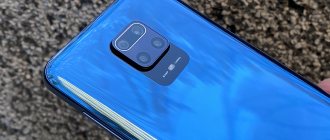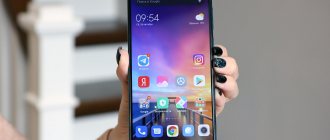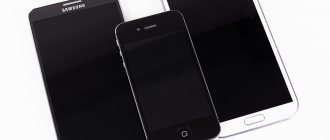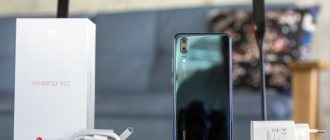Over the past few years, the budget device market has changed significantly both in terms of price and characteristics. Inexpensive smartphones from Xiaomi have become real bestsellers, surpassing global companies in the ratings. And here is the Redmi line suffered another evolution after the release of the seventh episode. Users were presented with the powerful Redmi Note 7 phone, the affordable Redmi 7 and the cheap Redmi 7A.
Today we will discuss a device called Redmi 7, because this mobile device contains the most optimal characteristics at an affordable price .
Specifications
First, let's look at the list of the main characteristics of Redmi 7 so that the user has an initial opinion about the phone.
| Display diagonal: | 6.29 inches |
| Screen resolution: | 1570×720 |
| Matrix type: | IPS |
| CPU: | Qualcomm Snapdragon 632 |
| GPU: | Adreno 506 |
| Number of Cores: | 8 cores |
| RAM: | 2/3/4 GB |
| Permanent memory: | 16/32/64 GB |
| Main camera: | 12 MP + 2 MP |
| Front-camera: | 8 MP |
| Battery: | 4000 mAh |
| Software: | Android 9 running MIUI 10. |
As you can see, we have before us a decent middle-class device , whose “filling” will definitely suit an undemanding user. You shouldn't expect excellent performance and a luxurious screen from the phone, because the price of Redmi 7 is quite budget-friendly.
Appearance
The smartphone does not boast an intricate design, but it looks quite neat and beautiful, and also stands out due to the gradient rear panel . The plastic cover can be easily protected from scratches and damage using a regular cover.
Many thanks to TechRadar for the photos.
Screen
Redmi 7 has impressive dimensions and a large 6.26-inch IPS . The screen is bright and contrasty: the resolution is 1520 by 720 pixels (HD+). But in sunny weather, unfortunately, there will be noticeable glare.
The frames are relatively small, only the bottom edge seems bulky. The front camera is placed in a special teardrop-shaped cutout.
Frame
The parameters of the mobile device are 158.73 × 75.58 x 8.47 millimeters , weight 181 grams . For watching videos and surfing the Internet, these are ideal indicators. If you like compactness, this model may not be suitable.
The smartphone is made entirely of glossy plastic, no metal inserts. Gorilla Glass 5 should reliably protect against damage .
Just above the center is a standard fingerprint scanner, and on the left is the dual main camera . There is a 3.5 headphone jack and an infrared port for remote control of equipment. Alas, the developers did not provide for the presence of Type-C; instead there is an outdated microUSB .
There are three main colors: blue, red and black. The first two colors are made as an iridescent gradient.
Xiaomi Mi 7 design, curpus
Without a doubt, the flagship Mi 7 will receive a frameless design and it’s even stupid to argue about it. Yes, for Xiaomi, framelessness is far from an innovation, and this is confirmed by the two smartphones Xiaomi Mi Mix and Mi Mix 2. However, the Xiaomi Mi 7 device will not be the same as the mixes, but will become a kind of parody of the iPhone X, that is, it will have a display in the entire front panel . Because of this, the smartphone will lose the Home button with a built-in fingerprint scanner, but as Apple’s practice shows, this is not a problem at all. At the same time, there is a high chance that the scanner will move to the back cover, because Xiaomi is not ashamed to do this even in top smartphones. The case, as usual, will be glass in the basic version and ceramic in the advanced version. Metal will not replace glass just because Apple has finally introduced wireless charging into its smartphones. It has long been a tradition for Xiaomi to make its flagships out of glass, but we mentioned Apple for a reason - Xiaomi Mi 7 will also receive wireless charging.
Iron
Redmi 7 boasts excellent performance , which simply has no competitors due to its low price. There is also a good selection of modifications available.
CPU
Qualcomm Snapdragon 632 platform , made using a 14-nanometer process technology . Let us remember that in previous inexpensive (some) models from the Redmi series, MTK processors were used. But in 2020, they are, frankly, clearly breaking through Snapdragon.
The Adreno 506 video accelerator is responsible for the graphics . Of course, the user will be able to play modern games, but only at minimum/medium settings with frequent sagging. But Redmi 7 can cope with everyday tasks (Internet, shooting, video, communication) without any problems.
Memory
There are three main modifications: 2/16 GB, 3/32 GB and 4/64 GB . There is no point in buying the minimum version, since 2 GB of RAM is not enough for modern use, and 16 GB storage will not be able to accommodate all the necessary information.
It’s better, of course, to take a closer look at the top modification, or, as a last resort, choose the 3/32 GB version.
You can also always expand your storage with a memory card up to 512 GB.
Communications
Nothing new or special here. There is Wi - Fi , Bluetooth 5.0 and navigation services . Of course, you shouldn’t rely on NFC, since budget models always lack a module for contactless payments.
Communication standards are common: 4 G ( LTE ), 3 G and 2G . A nice addition was the expanded slot, because you can install two SIM cards + a memory card. The older version, namely Redmi Note 7, no longer has this advantage.
Design
The smartphone is available in three colors: black, blue and Twilight Gold. The latter is closer to hot pink. Judging by the promotional photographs, all models, except the black one, shimmer and shine glossy in the sun. We got the most strict and universal dark modification.
The drop-shaped cutout in the center is the optimal solution for placing the front camera. But the smartphone does not feel frameless: there is a noticeable “bumper” and a doubly noticeable thickened lower edge. It's OK.
The Redmi Note 7 doesn't feel durable - it's not very weighty, and its back panel is suspiciously dull in response to taps. As tests have shown, these feelings are not deceiving: the phablet has vulnerabilities, and any serious fall may be the last. In addition, the sides are made of plastic and easily collect scratches.
The set includes a black silicone case. It's an angry decision, but it fits Redmi Note 7 perfectly - carrying a smartphone in a case is both useful and desirable.
On the left is a hybrid slot for two nanoSIM and microSD. There is no key to call an assistant. At the top there is an infrared port and a headphone input. On the right is a paired volume and power button, and on the bottom are the speaker holes and the Type-C input.
Like any phablet, Redmi Note 7 does not lie super comfortably in the average hand. With the lack of a lower curtain when typing, its dimensions are quite a problem. Even from the photo you can see how difficult it is to press the space bar or change the keyboard language.
The dust and moisture protection class is not declared.
The fact that this is not a flagship model, but a compromise, is clear at first sight and touch. For example, the phablet has the same screen resolution as the more expensive Xiaomi Mi 9 model, but greatly exceeds it in size and frame thickness. There is nothing wrong with this, considering that prices for Redmi Note 7 start at 14 thousand rubles.
Main and front camera
The Redmi 7's cameras are quite weak. The rear one has two modules: a 12-megapixel main one with an f /2.2 and a 2-megapixel (needed only for creating portrait photographs). The pictures will turn out average even in good lighting conditions.
To improve your photo quality a little, try installing Google Camera. This application improves pictures by adding brightness and contrast.
The front camera is only 8 megapixels . Yes, this is not enough, but compared to its predecessors, as much as 3 megapixels have been added. There are no special additional functions for taking selfies.
Xiaomi Mi 7 autonomy, wireless charging
The AMOLED matrix in the main Xiaomi device of 2020 already means that the display in the new product will be more energy efficient than any, even the highest quality IPS panel. The diagonal will increase, but the resolution will remain almost unchanged, which means the display in the new product will actually consume less battery. The same applies to the processor, because in the worst case its energy efficiency will not change, but in the best case it will improve. Most likely, the battery capacity in Xiaomi Mi 7 will undergo changes compared to Mi 6, but taking into account all of the above, autonomy will increase slightly. That is, Xiaomi Mi 7 will have to work for about a day and a half on one battery charge.
Since the Qi wireless charging standard will soon be implemented everywhere, it is logical to expect support for wireless technology in Xiaomi Mi7. It’s convenient, and buyers will appreciate the efforts class=”aligncenter” width=”1000″ height=”610″[/img]
Autonomy
The Redmi 7 has an excellent battery: the capacity is 4000 mAh . For an inexpensive phone, this is an excellent indicator, considering that even some modern flagships have no more than 3000 mAh.
In addition, fast charging is supported . With active use, the charge will definitely last for a day. To ensure your battery lasts as long as possible, read our instructions for proper use of the device, and also find out why the battery does not hold a charge well.
⇡#Autonomous work
The battery in Redmi Note 7 is installed the same as in Redmi Note 5 - 15.28 Wh (4000 mAh, 3.8 V). But at the same time, the screen has grown and a more powerful hardware platform has been installed. It is logical that the smartphone does not shine with autonomy. The Note 7 barely lasts for a day under standard load, but at maximum it barely survives the daylight hours.
In our traditional test of HD video playback at maximum brightness with updates and notifications turned on, the smartphone lasted exactly eight hours. Pretty good, but the decrease in performance compared to Redmi Note 5 is obvious.
The USB Type-C port is used for charging; Quick Charge 4 (18 W) is supported. But as expected, the kit does not include an 18-watt adapter – only a standard 10-watt one. With its help, it takes about two hours to fully charge the smartphone. Wireless charging is not supported.
Quick review of Redmi 7A
Most recently, the company showed at its presentation an ultra-budget smartphone called Redmi 7A. This is the younger version of Redmi 7, which received entry-level characteristics and low cost . Let's look at how this device may interest the user.
Appearance and display
The phone has a 5.45-inch screen with a resolution of 1440 by 720 pixels (HD+). There is no framelessness as such: the aspect ratio is 2:1. There are no cutouts in the top panel; the front camera is located in a wide frame.
The body is made of plastic without metal inserts. There are two color options: pale blue and black.
Performance and Memory
The mobile device is powered by a Snapdragon 439 with a maximum clock frequency of up to 1.95 GHz . Adreno 505 is responsible for graphics . Two modifications are available - 2/16 GB and 3/32 GB .
For communications, we have Wi-Fi 802.11b/g/n and Bluetooth 5.0 . There is also a GPS sensor, FM radio and a 3.5 headphone jack.
Main and front camera
The cameras on Redmi 7 are frankly weak and budget-friendly. The rear camera has one module of 13 megapixels + there is a flash and phase detection autofocus. The front camera with a sensor is only 5 megapixels , so you shouldn’t expect high-quality selfies.
Battery and cost
The state employee became the owner of a battery with a capacity of 4000 mAh . This is an excellent figure, which has increased significantly compared to previous cheap models.
Now about the price: the version with 2 GB of RAM and 16 GB of storage will cost $80 . For a more expensive modification (3/32 GB) you will have to pay $86 . Do not forget that for now we are talking about Chinese versions. Global ROM will cost more. The start of sales in the Middle Kingdom is scheduled for June 6, 2020.
Xiaomi Mi7 release date, price, buy
Previously, the release date was expected in February-March 2020, but the manufacturer shifted the release schedule, presenting the mid-priced device Xiaomi Redmi Note 5 in February (first in India and then in China), and in March rolling out an interesting update to its super-flagship called Xiaomi Mi Mix 2S. The announcement of Mi 7 was postponed to April and the expected presentation date is currently April 15, 2018. We hope that there will be no more postponements and the technology community will see the new flagship on this date.
Considering the new technologies that the device will receive, its cost may be higher than that of the Xiaomi Mi 6 when it was released last year. It is quite logical to see the price tag of Xiaomi Mi 7 in the region from 450 to 550 dollars.
You can buy Xiaomi Mi7 immediately after its presentation, ordering from China, and only two to three weeks later in online stores in Russia. As practice shows, the popularity of the brand’s new smartphones is very high and their first batches are sold out literally in seconds, so if you are interested in this model, you should monitor its appearance on the manufacturer’s official website and, if possible, make a pre-order.
Comparison of Redmi 7 with Redmi 6
| Image: | ||
| Model: | Xiaomi Redmi 6 | Xiaomi Redmi 7 |
| Display diagonal: | 5.45 inches | 6.26 inches |
| Screen resolution: | 1440x720 | 1570x720 |
| Matrix type: | IPS | IPS |
| CPU: | Helio P22 with a maximum clock speed of 2 GHz | Qualcomm Snapdragon 632 with a maximum clock speed of 1.8 GHz |
| GPU: | PowerVR GE8320 | Adreno 506 |
| RAM: | 3/4 GB | 2/3/4 GB |
| Permanent memory: | 32/64 GB | 16/32/64 GB |
| Main camera: | 12 MP + 5 MP | 12 MP + 2 MP |
| Front-camera: | 5 MP | 8 MP |
| Battery: | 3000 mAh | 4000 mAh |
| Software from the box: | Android 8.1 running MIUI | Android 9.0 running MIUI |
| Price: | Average price $128. | Average price $158. |
As you can see, Redmi 7 is significantly superior to its predecessor in terms of screen quality, performance and battery life.
⇡#Design, ergonomics and software
Nobody expects design feats from Redmi; these are smartphones not for aesthetic pleasure, but for utilitarian needs. But the usual classic approach in the case of Redmi Note 7 has given way to a look that is not devoid of grace. If reducing the notch to a “droplet” interspersed with a lone front camera was readable (almost everyone does this now), then replacing the metal back panel with a glass one is a move that is both timely and pleasant for a budget smartphone. Note 7 is that rare Redmi that, in terms of combination of price and characteristics (like the bright Honor 8X), is not inferior to its competitors, or even to examples of the “noble” approach, like Nokia 7.1 or Moto g7. The only thing he lacks is his own face, but this is not only a problem for Redmi today.
Moreover, this time Xiaomi did not skimp on interesting colors. In addition to the boring (but solid-looking) black version, which we tested, there are also blue and pink Redmi Note 7, with an iridescent body that is fashionable today, which slightly changes color depending on the external lighting and viewing angle.
Dimensions of Redmi Note 7 – 159.2 × 75.2 × 8.1 mm. In comparison with Redmi Note 5 (the intermediate Redmi Note 6 flew past us like a bright, but almost lifeless comet, so we will compare with the “five”) the dimensions have hardly changed (the differences are in millimeters, and there is both an increase and a “weight loss” ") despite the fact that the screen has become larger. Thanks to that very “droplet”, due to which the status bar rose a little higher. Moreover, in this case, the latter is not damaged - all the usual parameters are available, from battery percentage to network speed.
It is impossible to hide this “droplet” like a large cutout in Mi 8 or Redmi Note 6. The manufacturer considered that it would not interfere with the user. The opinion is controversial, but we can only agree with it - we have no choice, we cannot fill the status bar with black. When watching a video in full screen, the front camera will stick out right in the middle of the picture, albeit from the left edge.
Xiaomi Redmi Note 7, front panel: in the cutout is the front camera, above it is a slot for the earpiece speaker
Xiaomi Redmi Note 7, rear panel: dual camera unit protruding above the body, dual LED flash, as well as a fingerprint scanner
The back of the Redmi Note 7, I repeat, is made of glass – probably tempered, but Xiaomi does not provide specific information on this matter. It would be nice if it were tempered - the smartphone turned out to be very slippery. And even if it doesn’t try to crawl away from any uneven surface (the back is not curved), it is very possible to slip out of your hand. Welcome to the world of cases and bumpers. By the way, the set includes one made of “tinted” silicone.
Xiaomi Redmi Note 7, left side: slot for SIM cards and memory cards
Xiaomi Redmi Note 7, right side: power and volume/camera shutter keys
The set of controls is the most traditional: two keys on the right side and a fingerprint scanner on the rear panel. On-screen scanners have not yet arrived for Redmi, this is apparently a matter for next year. I won’t say that I’m very upset - capacitive sensors may not seem so advanced, but they now work much better than ultrasonic ones.
Xiaomi Redmi Note 7, top edge: 3.5 mm audio jack, IR port and microphone
Xiaomi Redmi Note 7, bottom edge: USB Type-C port and main speaker
There is also a 3.5 mm audio jack, but microUSB has finally given way to a USB Type-C port - now “micro” can be considered officially obsolete, Redmi Note here can be considered a watershed quite adequate to reality.
I already said about the fingerprint scanner above - it works quickly and without failures. If you wish, you can also enable facial recognition, but this is an absolute optional feature for those who are not very concerned about security. A single front camera is responsible for user identification.
Screenshot gallery
View all images (22)
Xiaomi Redmi Note 7 runs on the Android 9.0 Pie operating system with the current MIUI version 10.2. I already wrote about it in reviews of Mi MIX 3 and, most recently, Mi9. Compared to the latter, it is slightly simplified (the animations of the lock screen have changed) and at the same time it works better - at least I haven’t come across any untranslated pieces here. Otherwise, there are the usual advantages (many settings, fast and stable operation) and disadvantages (some of the icons, including Google services, for some reason are dressed in white squares; there is no normal search system in the smartphone’s memory; advertising is built into a variety of applications).
Comparison of Redmi 7 with Redmi 7A
| Image: | ||
| Model: | Xiaomi Redmi 7 | Xiaomi Redmi 7A |
| Display diagonal: | 6.26 inches | 5.45 inches |
| Screen resolution: | 1570x720 | 1440x720 |
| CPU: | Qualcomm Snapdragon 632 with a maximum clock speed of 1.8 GHz | Qualcomm Snapdragon 439 with a maximum clock speed of up to 1.95 GHz |
| GPU: | Adreno 506 | Adreno 505 |
| RAM: | 2/3/4 GB | 2/3 GB |
| Permanent memory: | 16/32/64 GB | 16/32 GB |
| Main camera: | 12 MP + 2 MP | 13 MP |
| Front-camera: | 8 MP | 5 MP |
| Battery: | 4000 mAh | 4000 mAh |
| Software from the box: | Android 9.0 running MIUI | Android 9.0 running MIUI |
| Price: | Average price $158. | Average price $86. |
For its price, Redmi 7A boasts excellent parameters. But it's still worth paying a little more and purchasing the older version if you want good performance and a high-quality display.
⇡#Camera
If the main weak point of the Redmi Note 7 is the lack of NFC, then the strongest point is perhaps the camera. The smartphone has a dual module with a backup camera, which simply helps blur the background in portraits. No zoom, no wide-angle mode. But this is not so important, because the main module is a 48-megapixel Samsung ISOCELL Bright GM1 (physical dimensions - 1/2'', individual pixel size - 0.8 microns). The same type as in Xiaomi Mi 9 and Honor View 20, but from a different manufacturer (they have a Sony IMX586 module installed - the Pro version is equipped with this sensor).
As in the models mentioned above, there is no optical stabilization, but in this case I don’t want to attack the gadget with reproaches; after all, we’re not even close to a flagship (except perhaps in the Redmi family). The focusing system is phase detection, it works quickly and confidently, no problems arise either during daytime shooting or in low light.
| On the left is a 12-megapixel photo, on the right is a photo with a resolution of 48 megapixels | ||
By default, the Redmi Note 7 camera shoots with a resolution of 12 megapixels (image size is approximately 4-5 MB), the Quad Bayer system is used with a group of four sensors per pixel. I talked about this in more detail in the review of Honor View 20. But you can still switch to the maximum resolution - to do this, you need to go to the “professional” mode and activate the setting. The output images already occupy 12-13 MB and add more detail, but not as significantly as it might seem “on paper”.
In the standard photography menu, the place of the 48-megapixel mode is taken by the “AI” icon, which connects neural network calculations to the process. The smartphone tries to recognize the situation and not just change the settings accordingly, but raise the saturation somewhere, adjust the exposure somewhere, and so on. This is done at the level of Mi 9 - in some places it looks appropriate, in others it is outright overkill. It's a matter of taste, of course, but you shouldn't get carried away with this regime.
| Two versions of a portrait taken in backlight with activated artificial intelligence | ||
Compared to Mi 9, the performance of the AI camera has even improved slightly (however, most likely, these functions have already arrived on the Xiaomi flagship with the new firmware). If you shoot a person in standard mode (without switching to portrait) against the light, the smartphone itself will ask what to do - increase the overall brightness of the photo or shoot a silhouette. Can choose. This is the kind of development of artificial intelligence in smartphones that I like.
In portrait mode, everything is standard - the background is blurred. You can turn on the beauty feature, but various lighting effects, like in Mi MIX 3 or Mi 9, are not available.
| On the left are pictures in the default format, on the right are with night mode activated | ||
But the night mode, familiar from older smartphones, is available, in which the camera takes several pictures, then combining them into one file with increased dynamic range and reduced noise. As a rule, it works well, although, as we know from the same Mi 9, there are also problems when the software “goes through” with increasing contour sharpness and saturation.
| Xiaomi Redmi Note 7 camera app interface | ||||
The camera application is standard for MIUI 10. There is also a watermark enabled by default indicating the model of the smartphone you are taking pictures with - do not forget to disable it in a timely manner.
The overall impression of the Xiaomi Redmi Note 7 camera is purely positive. Of course, it is largely adjusted by the price of the gadget; it lacks a lot to the flagship level: an optical stabilizer, a zoom, and wider shooting capabilities (various effects, shooting in RAW). But for its class this is really a very good level - Redmi Note 7 allows you to count on decent picture quality in any lighting. This is perhaps the first time when we can talk, if not about the leadership of a Xiaomi device in its class, then about a full-fledged claim for it.
Gallery of pictures
See all images (15)
Xiaomi still couldn’t cut down the shooting capabilities at all, removing 4K video shooting from the smartphone’s capabilities - only Full HD, with 30 or 60 frames per second. No stabilization is provided.
Selfies are taken by a 13-megapixel front camera with f/2.0 aperture optics. It looks like this is the same module as in Redmi Note 5, but for obvious reasons it lacks a flash. In terms of shooting quality, everything is very good. Spatial distortion is minimal, it is possible to blur the background, and the fixed focus distance is selected correctly.
Competitors
| Image: | |||
| Model: | ZTE Blade A7 | Xiaomi Redmi 7 | Huawei P Smart 2019 |
| Display diagonal: | 6.08 inches | 6.26 inches | 6.21 inches |
| Screen resolution: | 1560x720 | 1570x720 | 2340x1080 |
| CPU: | MediaTek Helio P60 with a maximum clock speed of 2 GHz | Qualcomm Snapdragon 632 with a maximum clock speed of 1.8 GHz | HiSiliconKirin 710 with a maximum clock speed of 2.2 GHz |
| GPU: | GPU ARM Mali-G72 MP3 | Adreno 506 | Mali-G51 MP4 |
| Number of Cores: | 8 | ||
| RAM: | 2/3 GB | 2/3/4 GB | 3 GB |
| Permanent memory: | 32/64 GB | 16/32/64 GB | 32 GB/64 GB |
| Main camera: | 16 MP | 12 MP + 2 MP | 13 MP + 2 MP |
| Front-camera: | 5 MP | 8 MP | |
| Battery: | 3200 mAh | 4000 mAh | 3400 mAh |
| Platform: | Android 9.0 | ||
| Price: | ~$103 (China) | ~$158 (Global) | ~$200 (Global) |
Review results
Do you want to purchase a decent mobile device at an affordable price? For you, the main thing is access to the Internet, the ability to watch videos and chat with friends? Take a closer look at Redmi 7.
For the money, this is an excellent device in the first half of 2019 . A moderately powerful processor, which is definitely enough for undemanding games, as well as a colorful screen and impressive dimensions.
I would also like to note the battery capacity, because 4000 mAh is a great indicator for an inexpensive phone. And, of course, quite good cameras and a standard set of communications.
Sound
I liked the external speaker of Redmi 7, it is not comparable to more expensive devices, even the same RN7, but unlike other budget phones, it does not hurt the ears with flat sound with completely absent lower frequencies at high volumes. The loudspeaker sounds quite loud, you definitely won’t miss an incoming call, and you can watch all kinds of videos quite comfortably.
The sound in the Redmi 7 headphones is comparable to any other inexpensive Snapdragon smartphones. If you don’t have high expectations, then there’s nothing to complain about. 99% of users will be satisfied with using the smartphone as a player; moreover, it can work with wireless headphones using the aptX codec.











